Home »
Citroen has released a new add-on for the Ami enabling anyone to convert their existing vehicle into a van.
When the Citroen Ami was first launched it the commercial vehicle version was a specific option on the price list. The Citroen Ami Cargo got a separate plastic partition instead of the passenger seat.
Now, Citroen has added a new commercial vehicle (or Ami Cargo) option pack to convert your existing Citroen Ami two-seater passenger car into an Ami electric van.
The new My Ami Cargo Kit module is offered as a retrofit accessory, replacing the Citroen My Ami Cargo version on the price list.
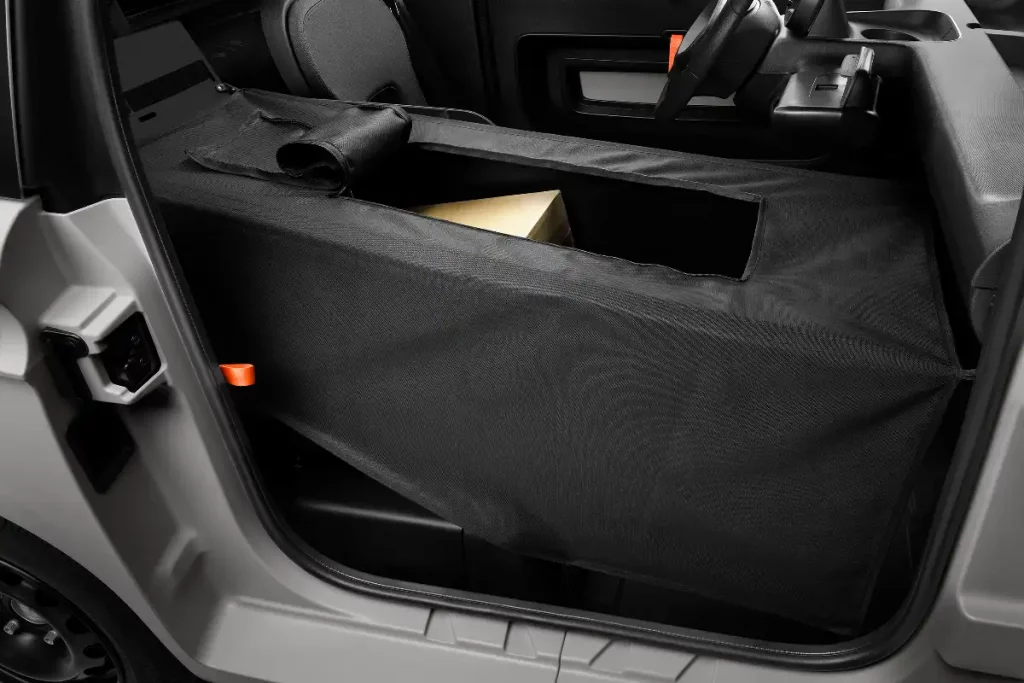
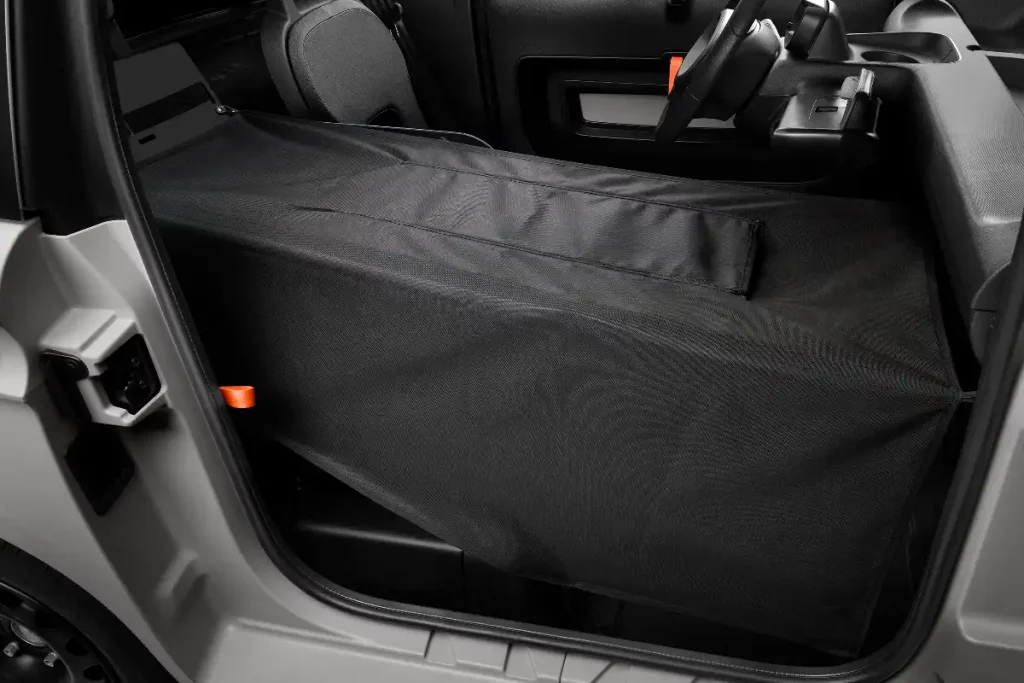
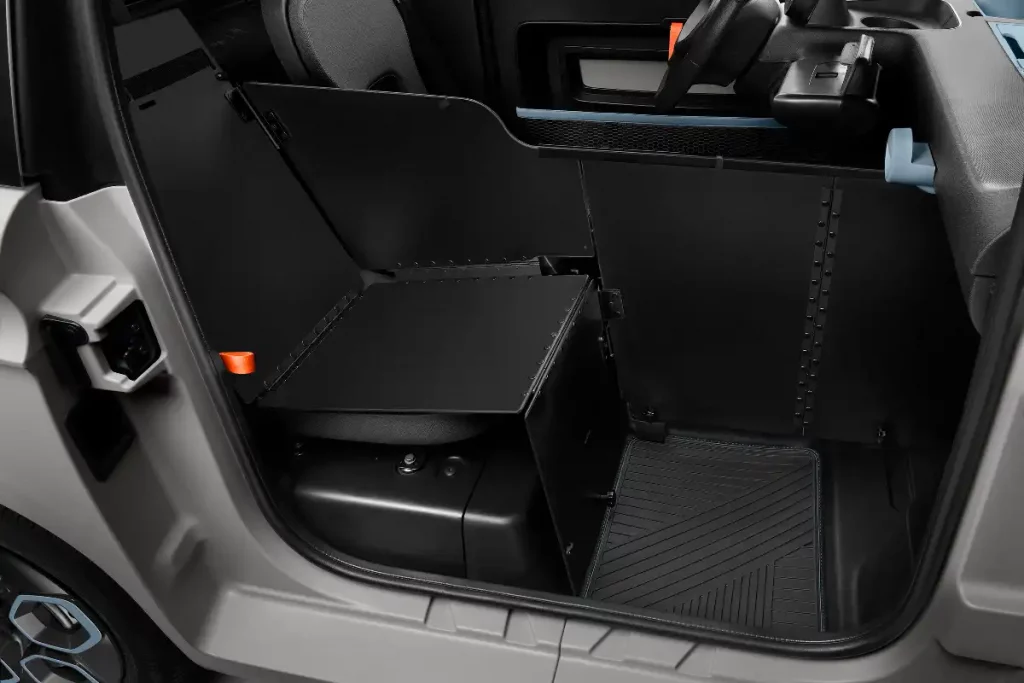
It’s now possible to switch the Ami into a cargo configuration (or back) in just five minutes.
The new Cargo van kit protects the second seat with two vertical panels to separate driver and passenger areas and four additional panels to create a practical loading surface. Items can be secured under a restraining net.
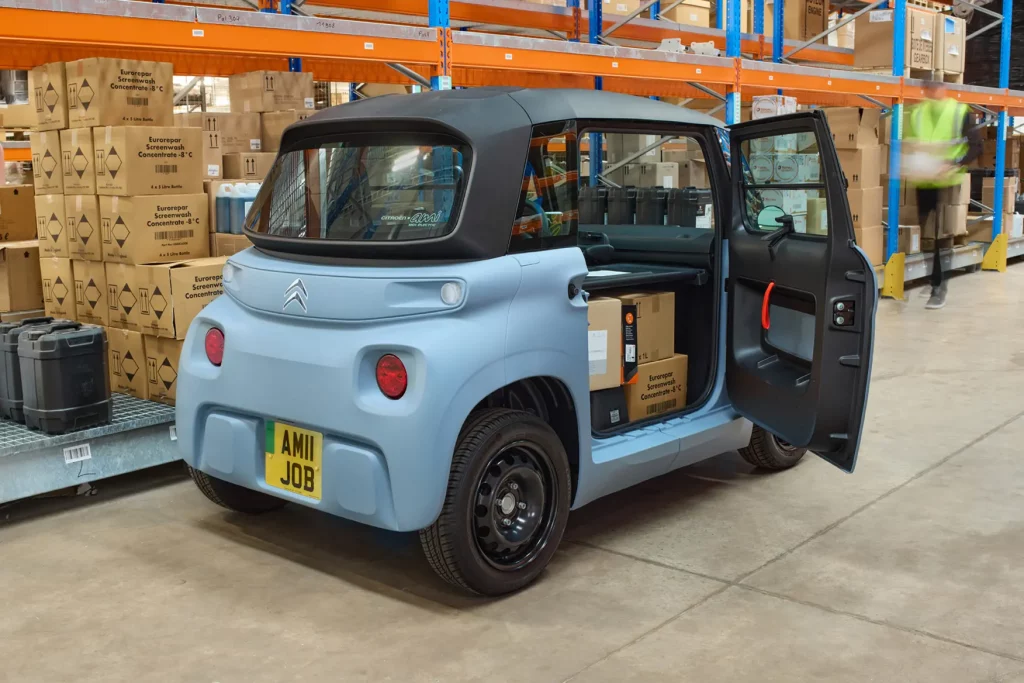
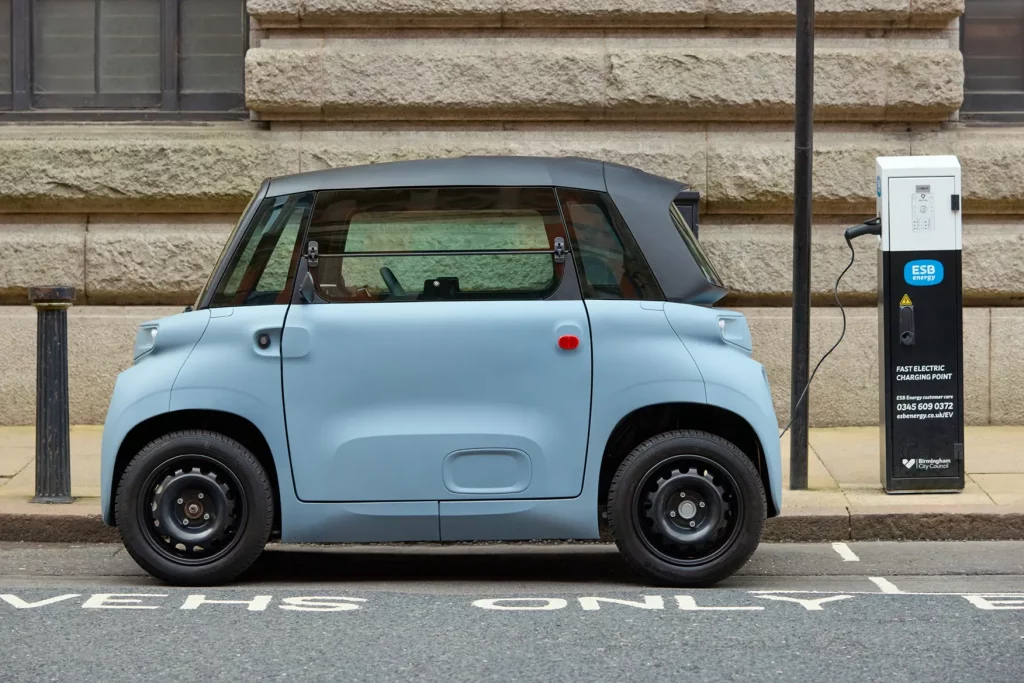
Citroen says the kit supports up to 200 litres under the net and has a total volume of 340 litres.
All of the Ami Cargo conversion kit also can be folded and stored behind the driver’s seat. That will allow you to quickly revert back to a two seater passenger car should you need.
The My Ami Cargo Kit is available to order immediately from the Citroën Online Store or from the Citroën retailer network priced at £259 (inc VAT).
Also relaunched is a new version of the regular Ami.
The range will now get a high-end My Ami Peps model that adds the 'best bits' from the Pop and Tonic models.
The Ami range will now start with the entry-level Ami and mid-range My Ami Orange, Grey, or Blue, finishing with the My Ami Peps which gets a black graphic band with yellow decals, black headlight rims, a rear spoiler, wheel covers, rear quarter graphics, and lower door decals.
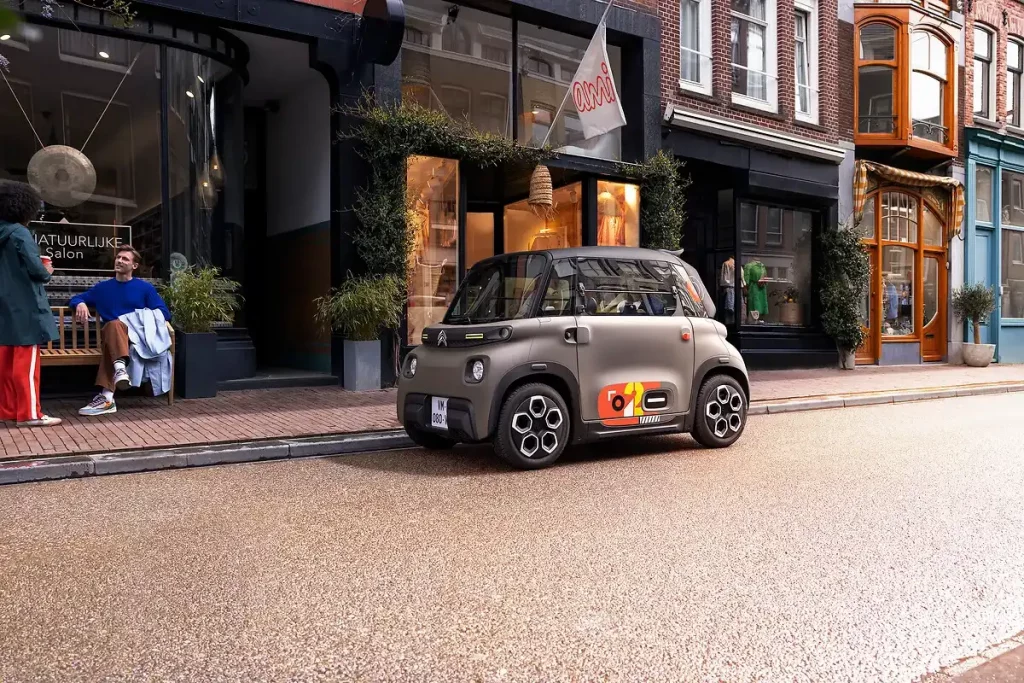
On the inside, the My Ami Peps gets a smartphone clip, orange-banded door nets, a central separation luggage net, a yellow bag hook, and three orange storage bins.
There's also orange straps and floor mat stitching.
The biggest change, however, is that the Citroen Ami Peps changes its standard colour from the grey-blue of the current model to a more green-brown colour called Night Sepia.
When it comes to medium-sized vans, the Stellantis-made Citroen Dispatch has one of the best towing capacity ratings in the sector.
The Citroen Dispatch towing capacity is up to 2.5-tonnes or 2,500kg which is the total towing capacity for a braked trailer on the latest van.
For towing an unbraked trailer the Citroen Dispatch has a towing capacity of up to 750kg.
The key question is:
The Citroen Dispatch panel van can tow 750kg with an unbraked trailer and 2500kg with a braked trailer.
There’s no doubt that the Dispatch towing capacity is better than many other mid-sized vans. The older versions limited to towing up to 2000kg, but the new Dispatch van can pull an even more impressive 2,500kg.
As a result, the towing capacity of the Citroen Dispatch is better than some of the competition. However, it is still well below the highest towing vans which are even greater on large vans. The towing capacity of a Sprinter van is even greater, comparable to the ratings of a pick-up truck.
Just how good the Dispatch is for towing will also depend on which model you decide to buy. That’s because all Dispatch vans have the same towing capacity of 2.5-tonnes. Irrespective of which engine you buy, the highest powered and the lowest horsepower versions all get the same towing rating.
There are both 125hp and 145hp versions to choose from, but of course towing a full trailer requires power, so our advice would be to opt for the Dispatch with the largest engine rating if you intended to make a habit out of towing something like a mini digger, fully loaded trailer or even a caravan with the Dispatch.
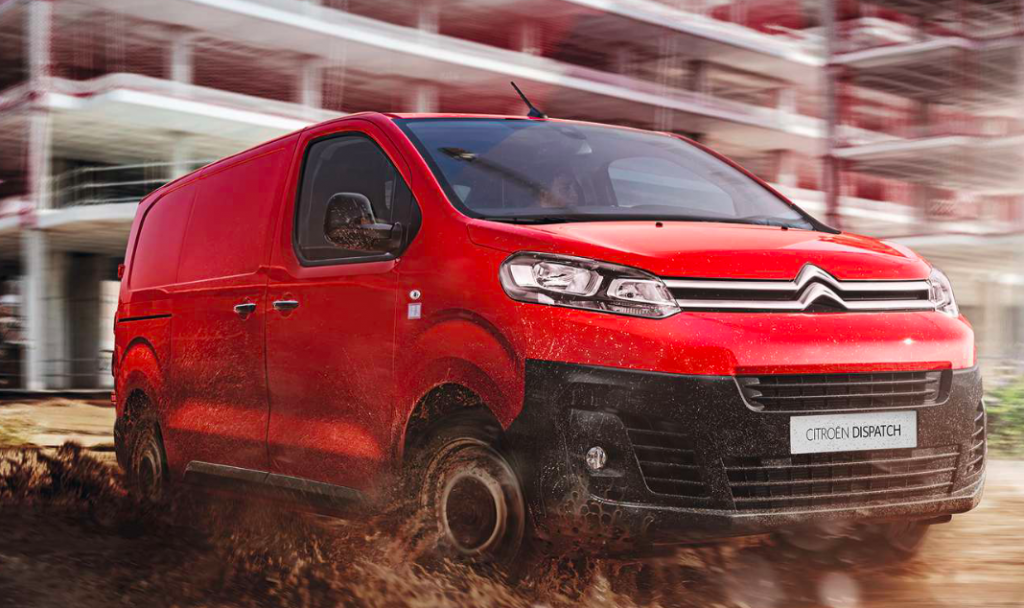
Unfortunately, there’s no catch-all solution to saying that the Dispatch can simply tow 2.5-tonnes. It’s not as simple as that because you need to consider the vehicles entire weight. That’s because the gross combination weight (GCW) or gross train weight (GTW) will have an impact on what you can pull with the Dispatch.
Essentially, the GCW or GTW is the weight of the van, plus any payload in the cargo area, and the weight of the trailer or whatever you are towing.
This is how you can determine the complete towing limit for the Citroen Dispatch and if it was an equation it would be: Kerbweight + Payload + Trailer Weight = GCW.
The gross combination weight of the Dispatch is a mercifully simple thing, that’s because all the models have the same figure, except for the double cab variants.
Double cab variants of the Citroen Dispatch have a gross combination weight (GCW) of 5.6-tonnes or 5600kg.
As the GVW (gross vehicle weight) – the weight of the van plus the maximum payload – is limited to 3100kg for the largest versions of the Citroen Dispatch, when you factor in the maximum 2500kg that is permitted for the weight of the trailer plus its payload, it means that it is impossible to exceed GCW (gross combination weight) even if you have a full payload.
That’s the general rule. Of course, there’s always an exception to the rule as that was the Citroen Dispatch 2.0 HDI towing capacity. So, if you have the 1.5-litre engine then be aware that it has a lower gross vehicle weight of 2830kg.
What that means is that you’ll just have to be more aware of the overall Citroen dispatch payload that you can have in the rear loadspace of the van.
As always, our advice is to check plates for the vehicle which can often be found either inside the door frames – most often on the passenger side – or under the bonnet of the van.
The Citroen Dispatch van does not come with a towbar as standard. There is, however, an option for one to be added as a factory option.
There’s a ball and hook tow bar option available on the Dispatch for all models which gives you a 13-pin connector plug to allow you to wire up the tow bar. It’s available (at the time of writing) for the princely £700 price tag for the Dispatch towbar.
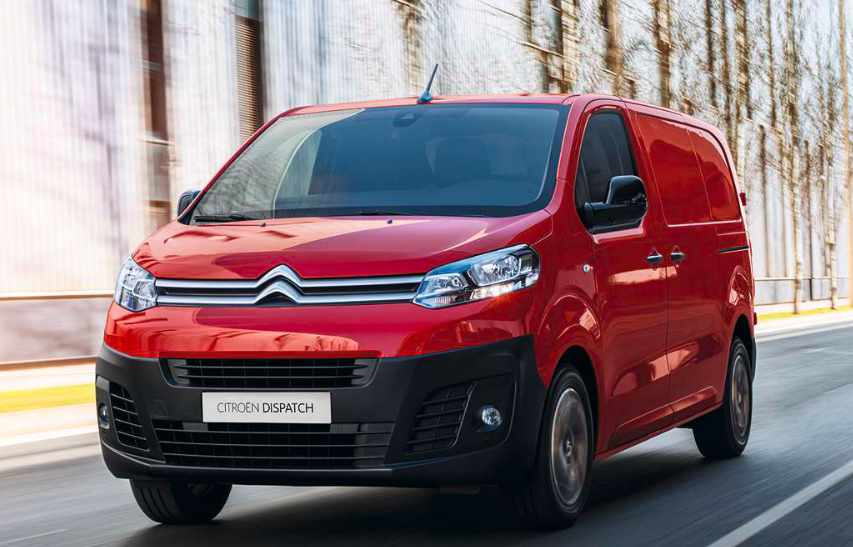
So, you want to know how to tow a Dispatch, well, you’ll need to find the van’s towing eye.
That’s the circular loop you’ll attach a towing rope of bar to. The towing eye location on the Dispatch can be found under the front bumper, off to the side of the main chassis arm. But you need to go under the front of the van in order to find the towing eye, and then you will also have to be considerate of the rope or bar pressing against the bumper itself when you are towing.
Stellantis electric van production site could be at risk, according to Stellantis UK group MD, Maria Grazia Davino.
Ellesmere Port is currently an electrification hub for production of the Citroen E-Berlingo, Fiat E-Doblo, Peugeot E-Partner and Vauxhall Combo Electric.
Speaking at the Society of Motor Manufacturers and Traders (SMMT) annual summit, Davino said the site near Liverpool as well as Vauxhall’s factory in Luton could be in jeopardy if more wasn’t done by government to increase demand for zero emission vehicles.
The decision to halt production at one or both sites could come as soon as a year.
Davino said: “Stellantis UK does not stop, but Stellantis production in the UK could stop.”
Electric van production is due to start in Luton next year when it will make the medium sized electric vans in the group which include the Citroen E-Dispatch, Fiat E-Scudo, Peugeot E-Expert and Vauxhall Vivaro Electric.
“We have undertaken big investments in Ellesmere Port and in Luton, with more to come. If this market becomes hostile to us, we will enter an evaluation for producing elsewhere,” Davino explained.
The UK government has set a goal to ban sales of new petrol and diesel cars by 2035 - initially their plan was to introduce the ban in 2030.
With all parties currently on the campaign trail ahead of the 4 July general election, key climate change messages and how future governments will tackle them have become an important manifesto element.
Increasing threats from the EU to impose tariffs on Chinese built vehicles is also causing unrest in the industry.
After an EU indication that costly tariffs could be imposed on Chinese manufacturers - that would include Maxus and models including the recently launched Maxus eDeliver 5 and Maxus eDeliver 7 - several European manufacturers chastised the idea, including global Stellantis boss Carlos Tavares.
Stellantis ProOne was created towards the end of last year to symbolise the unification of the many Stellantis brands that now exist under its commercial vehicle umbrella. Citroen, Fiat, Peugeot and Vauxhall brands are now all built off shared platforms producing an unparalleled number of vehicles. With small, medium, and large models from four brands as well as internal combustion engine (ICE) and electric powertrains, there’s 24 individual models. Now, all of them which have been refreshed in some way, simultaneously in an unprecedented renewal of their light commercial vehicle line-up.
But the models aren’t just limited to battery electric vehicles (BEV) and diesel (and some petrol) engine models. Stellantis has also been working on incorporating hydrogen fuel cells into its van range with a mid-sized van available in France and Germany since 2022. Built as a manual conversion, off the production line, the medium-size hydrogen (built as the Vauxhall Vivaro-e Hydrogen) has enjoyed a degree of commercial success but has helped inform the production of an additional model on the large van platform chassis. Due to payload and range compromises for large BEV vans, hydrogen makes considerably more sense, increasing range, reducing “refilling” time compared to EVs and maintaining payload – all while being zero emission. Despite a slow proliferation of hydrogen filling stations across Europe, a European Commission roadmap to create refuelling points within 200km of each other across the entire network of major EU roads will enable hydrogen vans to become viable for many more customers.
However, creating a hydrogen vehicle using an existing platform is not a straightforward process. Renault-owned Hyvia has opted to install its hydrogen tanks on the roof for its first-generation van in an effort to become first to market with a large fuel cell LCV. While the next generation Renault Master (deliveries for which will begin later this year) will enable hydrogen fuel tanks to be incorporated into the chassis, Stellantis have managed to modify the configuration of their mid-sized van’s fuel cell system into the larger model thanks to its renowned ability to work for conversions – largely in the campervan segment.
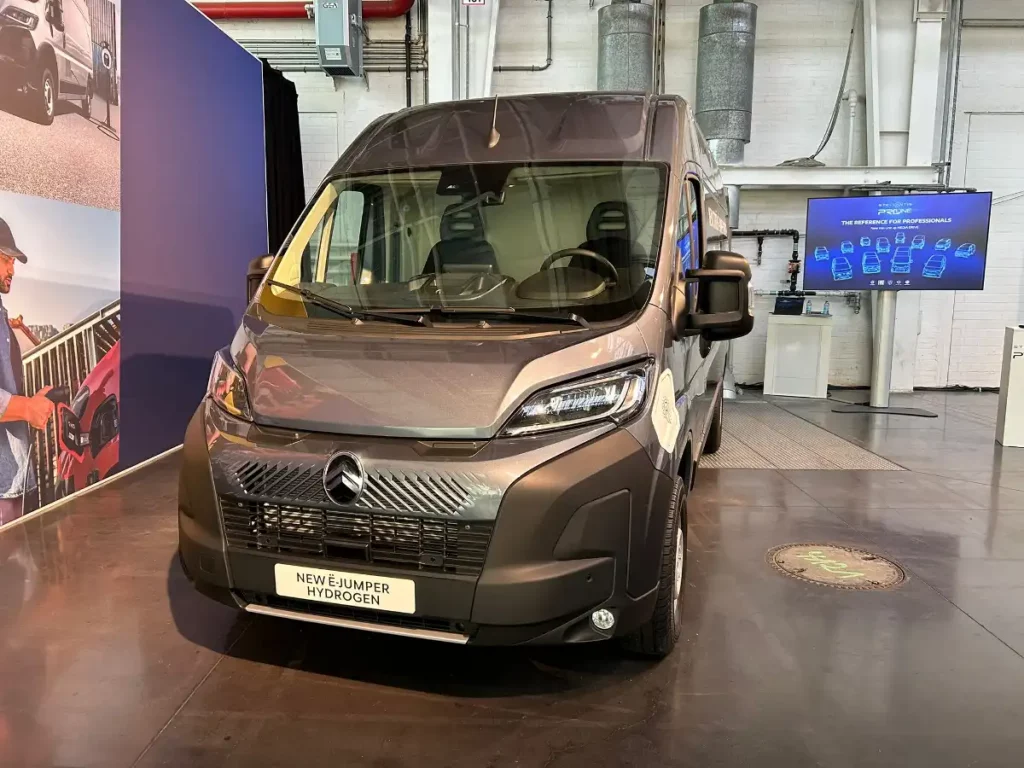
“The installation of the fuel cell system was more challenging than in the mid-sized van,” explains Stellantis hydrogen programme chief engineer, Peter Gross.
“The large van in terms of interior to exterior dimension is best in class, there’s’ nearly no empty packaging space left, so that is why the package looks quite different to the medium-sized van,” he explains.
While both medium and large vans are based on their BEV siblings. The large hydrogen vans will be available using the Citroen E-Relay platform, as well as the Fiat E-Ducato, Peugeot E-Boxer and Vauxhall Movano Electric. The medium van hydrogen fuel cell is based on the Citroen E-Dispatch, Fiat E-Scudo, Peugeot E-Expert and Vauxhal Vivaro Electric, all of which used the space under the bonnet to stack the fuel cell on top of the electric motor used to drive the front wheels. Gross explains that in the larger version this didn’t work, prompting his team to look elsewhere. They opted to use the location previously utilised by the large van’s diesel tank, located under the front seat.
“Package space was found under the front seat, there is a large diesel thank that has been removed and with some modification of the sheet metal there was a chance to put the high voltage battery and the fuel cell stack into this space.”
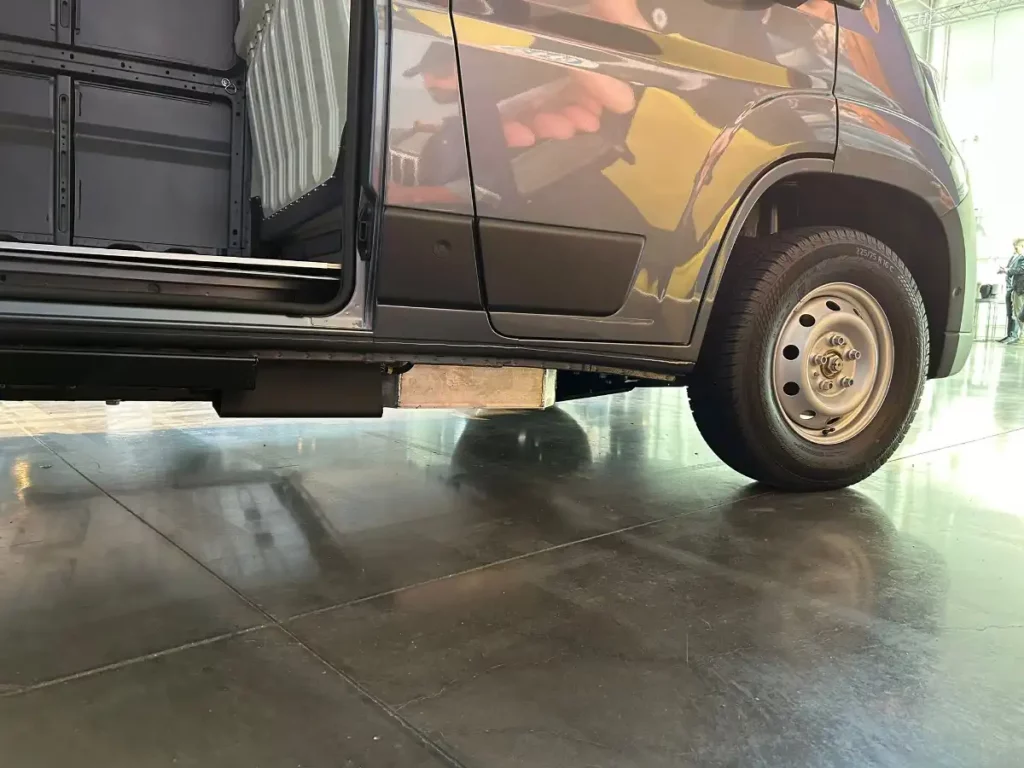
The new location has mean that the air filter now sits in the front of a van, feeding air to a cathode just behind it that is linked by pipework to the fuel cell under the seats. Hydrogen is then fed into the fuel cell from the tanks located in the rear of the van between the chassis rails. Power is then either used for propulsion or stored in the battery underneath the fuel cell. Apart from the layout, there’s also one other significant difference between the medium and large vans.
“In the mid-sized van the battery was actually in the interior of the vehicle, but in the large van it’s in the floor with the other [components],” Gross explains. The result is an easier and more logical installation that, unlike the medium-sized van, will enable the large hydrogen van to come as a right-hand-drive van as early as next year. Unfortunately, the same isn’t true of the mid-sized van. Despite Stellantis launching the van more than a year ago and having moderate success in France and Germany – two countries with a relatively established network for hydrogen refuelling – it is only now just being rolled out to additional markets. The Netherlands, Belgium and other countries in western Europe all feature on the product plan, however, the UK will not for this generation of vehicle. Gross says that it will take a few years for the medium van to be available in right hand drive with a fuel cell, which will be for the next generation of van.
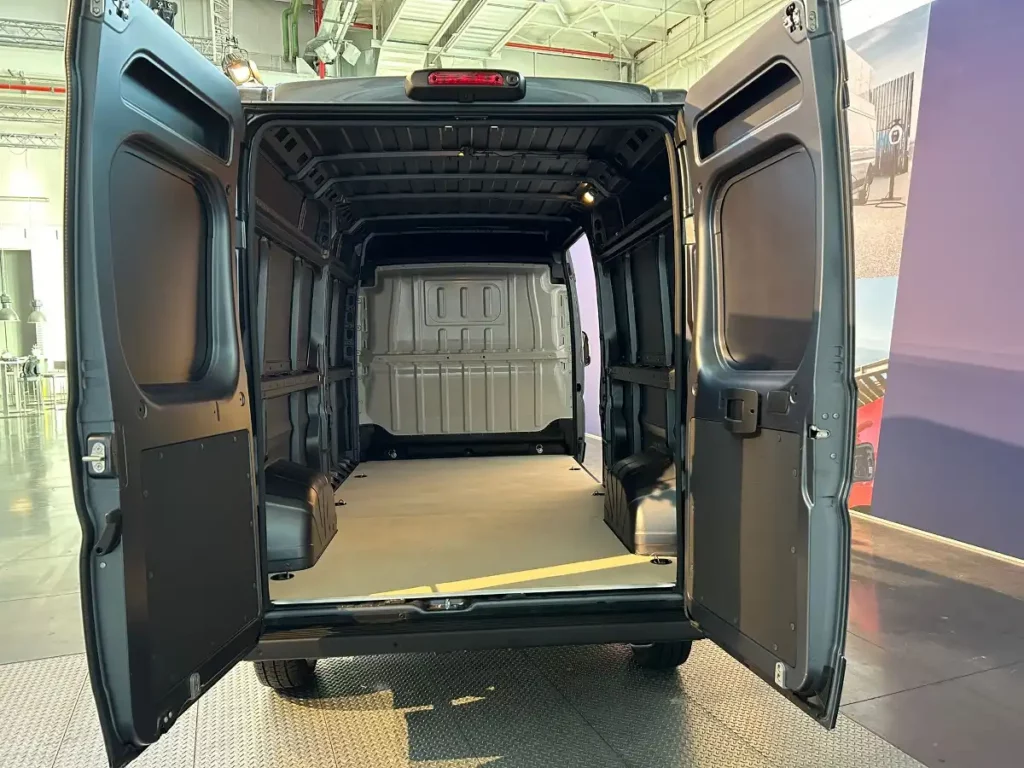
On the other hand, the large van was “considered from the very beginning” according to Gross due to our well-developed home delivery and courier services. While the UK doesn’t have a public infrastructure capable of supporting private use of hydrogen fuel cell vehicles, Stellantis is clearly expecting some private businesses to invest.
“It’s well known that the UK is very open to alternative fuels and the fuel cell proposition,” Gross explains.
“The medium van, will not come as right hand drive in the next few years. It will come with the next generation. Physical constraints are always an issue if you take an existing vehicle and want to install fuel cell components you have to live with certain restrictions,” he adds.
Despite no right-hand-drive hydrogen medium vans, Gross says they’re growing in popularity. They’ll also greater visibility later this year when being used as passenger vehicles around Paris during the Olympics.
“The market demand is growing, and it’s important to have these products available to give customers options. There is no other OEM offering mid-size and large hydrogen vans. With the European Highway, the door will be open to use these vehicles all over Europe,” Gross says referring to the EU’s hydrogen road map.
With hydrogen uptake and infrastructure being such a chicken and egg scenario, building a viable product is the best solution manufactures can have. That’s why Gross says considerable effort was made to ensure that as much hydrogen was able to be carried as possible. The addition of a fourth tank, compared to the medium van’s three, makes the large van a much more usable prospect for the fleets that are likely to be the primary buyers. That capacity, however, was only possible due to the large van’s innate ability carry payload. Luca Marengo, Stellantis commercial vehicles head of global product, attributes that to the van’s design and long standing success as a converted vehicle.
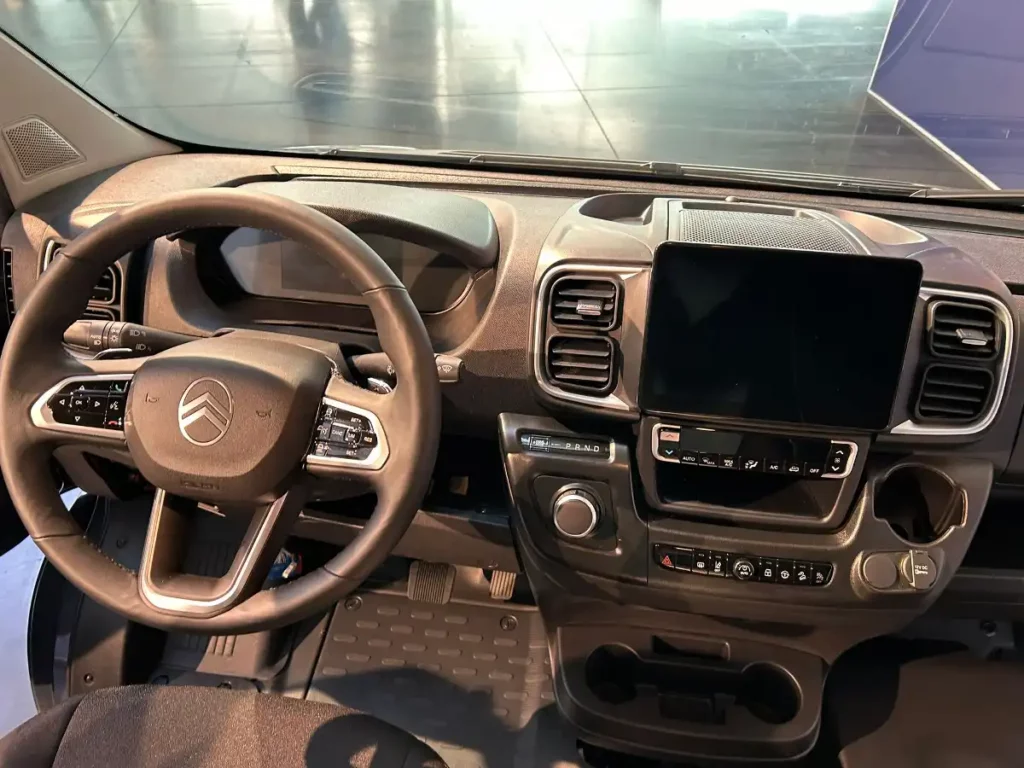
“The Ducato and these [large Stellantis] vans have always been popular with conversions, particularly motorhomes. Storing clean and waste water is something they have always done. That has helped with the space in the chassis for the hydrogen,” Marengo explains.
Ultimately the market will decide how much of a success hydrogen vans will become, but with large vans and fleet customers, they stand a fighting chance. The scalability of the design will also help with a powertrain used across medium and large vans, there’s hope that like electric motors and modular battery packs, volumes will reduce the price and bring hydrogen to the mass market.
Stellantis is one of the world’s largest car manufacturers, created in 2021 with the 50:50 merger of PSA Group Peugeot-Citroen and Fiat Chrysler Automobiles. They are amongst the largest vehicle manufacturers in the world with ambitions to become the largest.
As a result of the Stellantis buyout, the newly formed Stellantis company suddenly found itself with a lot of different owners including majority shareholders of both previous companies – namely the Peugeot family of France and the Agnelli family from Italy.
Fiat Chrysler Automobiles (FCA) was largely owned by the Agnelli family and as such took a majority stake in the new company through its business, Exor. As majority owners of PSA Group (Peugeot-Citroen), the Peugeot family also took a sizeable share in the business, as well as investment arms for the French government, Bpifrance. Additional shareholders include Chinese vehicle manufacturer Dongfeng Motor Corporation.
The resulting company was listed on the Milan and Paris Stock Exchanges as well as in America on New York Stock Exchange (NYSE) where it uses the ticker $STLA for trading.
Stellantis is technically registered and headquartered in The Netherlands. Officially, the business headquarters of Stellantis NV is located in Amsterdam, The Netherlands, with its corporate office in Taurusavenue 1, 2132 LS, Hoofddorp, The Netherlands.
Functionally, there are actually several bases of operation including Milan, Paris and Detroit. This is a result of the merging of many of the corporate entities into Stellantis and their own headquarters. Considerable cost-cutting, however, has seen a number of premises sold or the leases lapse. Perhaps most famous of all is the Lingotto building, once the headquarters of Fiat. Lingotto is most famous for its rooftop test track, immortalised in The Italian Job film. The Lingotto test track is now closed, but it is still walkable on foot. A portion of the rooftop is now used as an outside dining area for a restaurant. The iconic banked section of the Lingotto roof top test track is, however, still used for advertising and commercials. Stellantis no longer owns the Lingotto building.
The Stellantis companies are the merged parts of the PSA Group and Fiat Chrysler Automotive.
Under the merger of the two companies a huge number of iconic names came together. The full number of Stellantis brands now totals 14 car companies, with many other names consigned to the history books. So, what brands are Stellantis? The current Stellantis brands of active car companies is Arbarth, Alfa Romeo, Chrysler, Citroen, Dodge, DS Automobiles, Fiat, Jeep, Lancia, Maserati, Opel, Peugeot, RAM and Vauxhall. There are also additional non-manufacturing brands related to finance and mobility. These are Free2move and Leasys.
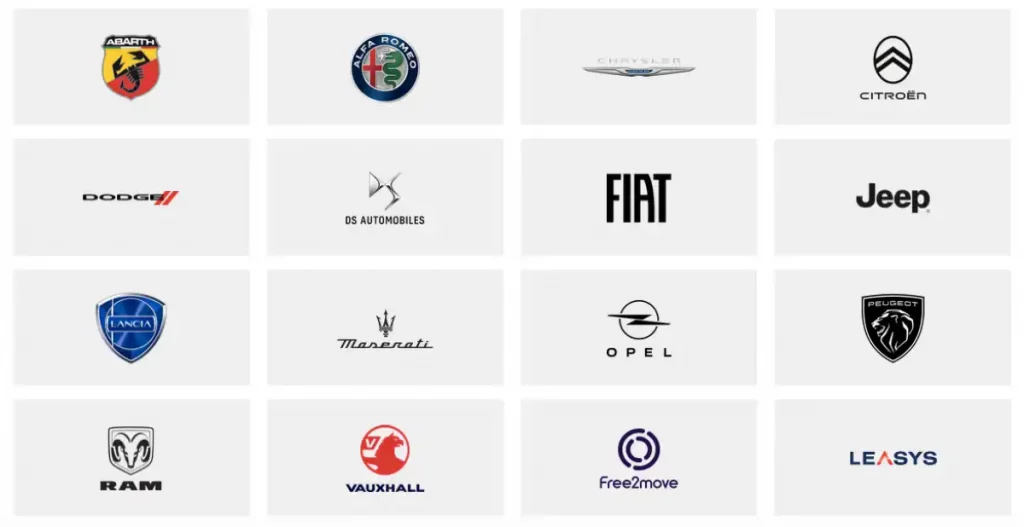
The Stellantis logo, unveiled at the launch of the company, is the world Stellantis in capital letters. The A in the centre of the word is surrounded by a circular sea of stars, while the central horizontal line of the A is also missing which makes the converging lines look like a road. The name is said to come from the Latin verb ‘stello’ which means adorned with stars.

The Stellantis CEO is Carlos Tavares. Tavares (pictured) is an accomplished automotive sector businessman, having previously been PSA Group CEP and President of the managing board. Tavares is known to be a shrewd businessman with a keen key for cost cutting and leveraging economies of scale. There have inevitably been a few Stellantis layoffs as a result of the merging of functions under the new company.

The Stellantis Chairman is John Elkann, heir to the Agnelli empire and a notable Italian businessman and industrialist. He is the CEO of Exor, part-owner of Stellantis, with controlling stakes in Ferrari, CNH Industrial (makers of Case New Holland tractors) and Iveco Group (makers of Iveco vans and trucks).
Announced in 2023, Stellantis Pro One is the collective name for the commercial vehicle brands within the Stellantis group of companies. Stellantis Pro One brands include Citroen, Fiat Professional, Opel, Peugeot, RAM and Vauxhall. Stellantis Pro One builds vans and other light commercial vehicles including pick-up trucks, software solutions for telematics and vehicle tracking, as well as manufacturing white label products for partners like Toyota vans.
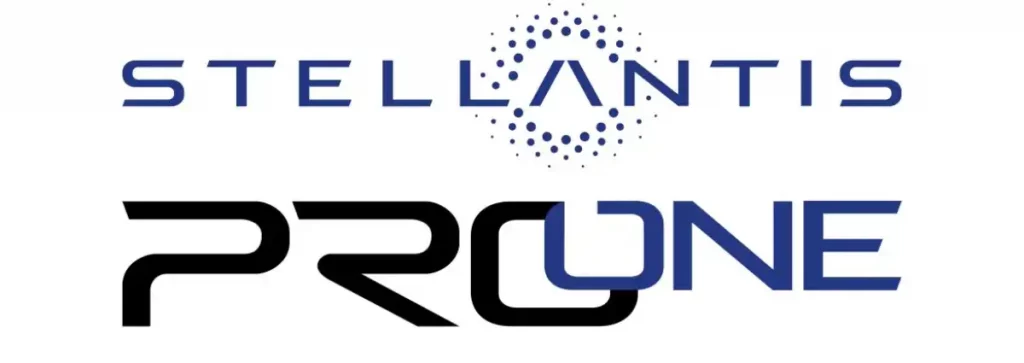
Stellantis currently makes more than 100 individual models in Europe alone with many more in markets across the world. Stellantis brands are sold in more than 130 countries.
Stellantis has the largest van product range of any automotive manufacturer. You've come to the right place to find out about them all too. The vans that Stellantis make currently includes the Citroen Berlingo, Fiat Doblo, Opel Combo, Peugeot Partner, Vauxhall Combo, Citroen Dispatch, Citroen Jumper, Fiat Scudo, Opel Vivaro, Peugeot Expert, Vauxhall Vivaro, Citroen Relay, Citroen Jumpy, Fiat Ducato, Opel Movano, Peugeot Boxer, RAM Promaster and Vauxhall Movano. There are also electric versions of each of those models, as well as passenger van versions of the car-derived vans, chassis cabs, Luton vans and other derivatives.
No. But, one of the Stellantis owners does. Ferrari was part of the Fiat empire owned by the Agnelli family. Its historic name, however, carried so much clout that it was separated from the Fiat Chrysler Automobiles group of companies in order to strengthen it and increase profits. Therefore, Stellantis does not own Ferrari, but Stellantis shareholder Exor (run by Stellantis Chairman John Elkann) does.
Yes. Jeep was one of the Chrysler brands brought into the Fiat Chrysler Automobiles group when the Detroit manufacturer hit the skids in the global financial crisis of 2008.
Yes. Dodge was another one of the Chrysler-owned names that Fiat acquired when it bailed out the American giant and took it out of Chapter 8 bankruptcy.
Yes. Maserati has long been part of the Fiat Automobile Group and along with its famous Italian sibling Alfa Romeo was part of the companies merged into the creation of Stellantis.
Yes. Stellantis owns Fiat as part of the new structure of the combined companies of Fiat Chrysler and PSA Peugeot-Citroen.
Yes, Chrysler became a part of Stellantis as part of the merger of Fiat Chrysler Automobiles and PSA Group.
No. Despite a significant number of its sales, production and even brand names being of American origin, the Stellantis company is technically Dutch and is incorporated in The Netherlands. Stellantis does contain American car brands Dodge, Jeep, RAM and Chrysler.
Stellantis has production sites in 29 countries, and sells vehicles in more than 130 countries. The number of employees on the payroll is said to be in the region of 400,000 people.
Stellantis ProOne’s new hydrogen large van will come in right-hand-drive as early as next year.
Unlike the mid-sized version of their hydrogen fuelled van – currently available in France and Germany as the Vauxhall Vivaro-e Hydrogen – the large van will be based off the Citroen E-Relay, Fiat E-Ducato, Peugeot E-Boxer and Vauxhall Movano Electric battery electric vans. It uses a combination of a 110kW motor paired to a 45kW fuel cell with an 10.5kWh battery pack.
Hydrogen storage is from four vessels providing a total of 7kg of usable H2 and an expected range of more than 500km.
In comparison, the mid-sized van uses three vessels to give the van a 400km range.
The van will be available in L3H2 and L4H3 sizes giving a total loadspace of 13m3 and 17m3 as well as a 1,300kg payload.
The large van can be fuelled at 700 Bar enabling a fill-up time of less than five minutes.
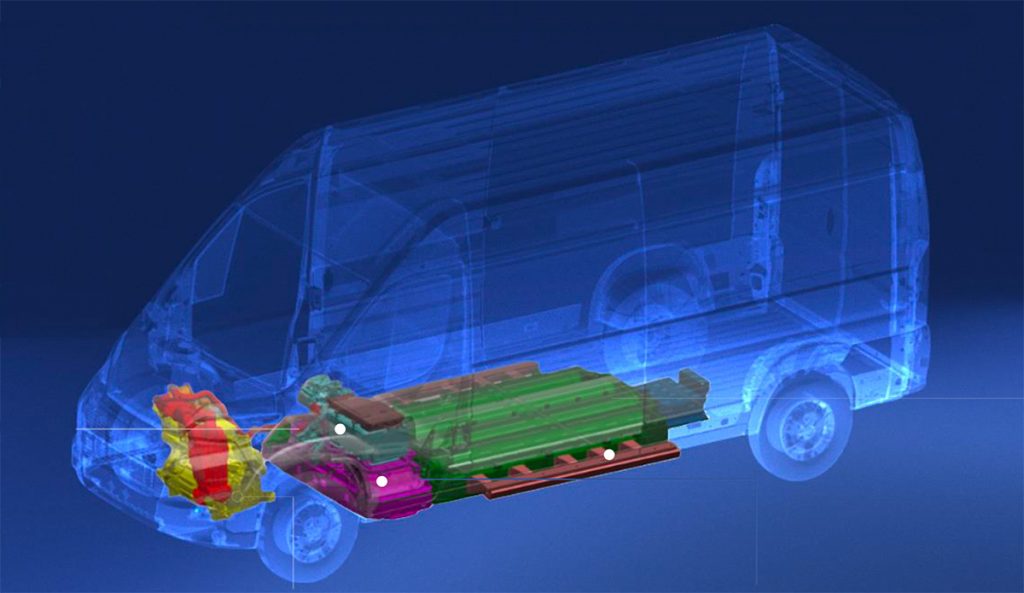
Stellantis’ decision to increase their efforts into hydrogen products are reflected in the EU Council’s decision to create the Alternative Fuels Infrastructure Regulations (AFIR). All EU countries will be required to deliver a viable hydrogen refuelling network with one 700 Bar hydrogen station located every 200km on all main corridor routes. They will also have to have 1 station for each assigned urban node in order to aid refuelling in cities. EU countries will need to have completed the network by 2030 which should create more than 500 filling stations across the EU member states.
Currently there are around 150 public H2 filling stations with the majority in Germany, France, Netherlands and Switzerland.
While the mid-sized H2 van is scheduled to be rolled out to more European countries this year, including Netherlands and Belgium, a right-hand-drive version for the UK will not come until the next generation of medium sized vans is introduced in several years time. Instead, the large van will be rolled out across Europe and to North America after 2025 when a hydrogen fuelled pick-up truck – under the RAM brand – will also be brought to market.
In a major boost for the town, Luton will begin production of new electric models next year for the entire range of Stellantis medium vans sold in the UK.
The plant will mostly be producing right-hand-drive versions of the Stellantis range of vans that include the Vauxhall Vivaro Electric, Peugeot E-Expert, Citroën ë-Dispatch and Fiat Professional E-Scudo. However, the site will also be used to produce some left-hand-drive versions of the same models for export as well as the Opel Vivaro Electric.
Production will begin in the first half of 2025 in limited numbers, and the electric vans will be produced alongside their internal combustion engine counterparts.
Luton joins Ellesmere Port as the second electric model manufacturing site for Stellantis vans in the UK.
Ellesmere Port was announced as the manufacturing site for all versions of the Citroen e-Berlingo, Peugeot e-Partner, Fiat e-Doblo and Vauxhall Combo Electric in September last year, following a £100m investment to transform the plant for EV production. It is also became the first Stellantis plant globally to be dedicated to electric vehicle manufacturing.

Stellantis is currently the best-selling van manufacturer in Europe with a 30.4% market share in 2023. Their electric vehicles also have a 38.8% of the European market, while in the UK that figure rises to 47.9%. Vauxhall was the best-selling electric van manufacturer with 6,402 sales out of Stellantis' total UK sales of 10,272 vans. The majority of Vauxhall's electric van sales were for the Vivaro Electric as the number one electric van in the UK.
Vauxhall's Luton plant began life in 1905 and have been producing the Vivaro van since 2001. When Stellantis acquired Vauxhall and production was switched over from producing Renault-based vans to the Peugeot-Citroen model, the plant also took on group production of medium-sized vans, adding the Fiat Scudo in 2022.
Mark Noble, Luton Plant Director & Stellantis UK Manufacturing Lead, said: “Following the transformation of our Ellesmere Port facility to produce all-electric compact vans, I’m pleased to announce that we will commence limited production of our medium electric van in Luton from next year, when the first customer vehicles will roll off the production line. This is a fitting way to mark Luton’s 120th anniversary.”
Luton produced more than 90,000 vans last year, all of which were ICE models.
Citroën will enter the camper market after showing a new Type Holidays camper at the Düsseldorf Caravan Show which mimics the famous Type H van.
The new camper is a one-off built on the Citroen SpaceTourer model with a pop-up roof, bench seat that converts into a bed, fold-down table eating area and a kitchen.
Designed to look like the H van – most commonly found now as mobile food trucks at trendy street food markets – the concept is the first in what will become a range of campers built on the Citroen SpaceTourer model with the same interior layout as the H van.
The Type Holidays camper is the work of Italian coachbuilder Caselani who have in the past also created other ‘neo-retro’ bodies of Citroen models.

It gets a pop-up roof, which is high enough to allow someone to stand upright in the living space area. It is also large enough to fit a double bed, giving the van space for four when using the fold flat bed of the rear bench seats. The rear bench seat is also completely removable to improve storage space, while the two front seats are swivelling captain chairs that can rotate to the living area to give comfortable four seat dining around the fold-out table.
There’s a complete kitchen with a cooking area, mini sink and fridge as well as several storage cupboards for pots and pans.

The retro exterior styling imitates the corrugated look of the original Type H van but combined with a modern interior suitable for a family getaway. Although Citroen is the second largest supplier of motorhome chassis in Europe, the Type Holidays is the beginning of a new line of camper van models set to be part of the Citroen range.
Citroen says that the brand will introduce a dedicated range of camper vans that will be sold through the Citroën network, in the coming months. More details will be available later on in the year.
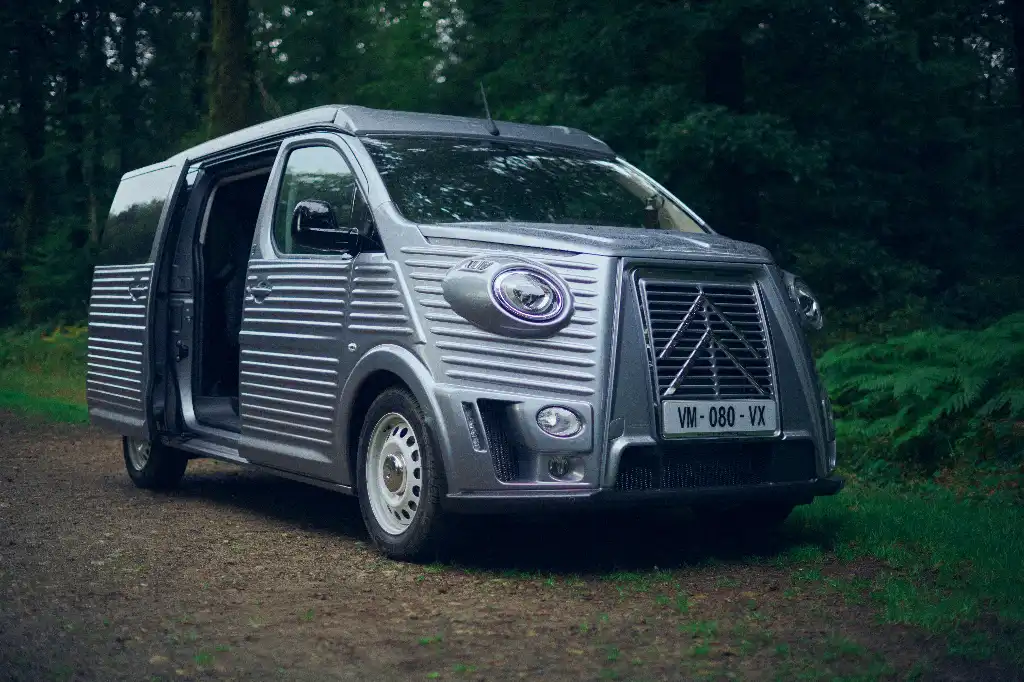
Fiat has unveiled the Fiat Topolino based on the Citroen Ami and Citroen Ami Cargo.
The Topolino is an all-electric quadricycle that aims to enhance urban electric mobility while embodying the spirit of its namesake and iconic Fiat 500.
Designed to bring a fresh sense of la dolce vita to city streets, the Topolino caters to a wide range of customers, including younger drivers, families, and urban enthusiasts. Fiat's objective is to offer accessible and sustainable mobility solutions for everyone.
The chosen name, Topolino, holds a significant historical value and immediately evokes memories of the first Fiat 500.
The original Topolino, produced by Fiat between 1936 and 1955, revolutionised the automotive industry and became an icon in its own right.
Unlike the Citroen Ami, there are no plans for the Fiat Topolino to be made available in right hand drive. There are also no indications that there will be a commercial vehicle version of the electric van. Originally launched as a Citroen product, the Ami is available as the Citroen Ami Cargo, a compact van with a miniature payload and load volume.
The Citroen Ami Cargo has 400-litres of storage the equivalent of 0.4 cubic metres. It also gets a payload of 140kg. That's because it uses the allowance you’d have for a passenger.
The Fiat Topolino will only be available as a passenger version, with just two seats. The car has a roll top roof and rope doors. It is very similar in design to the limited edition Citroen Ami Buggy. The retractable roof is made in brown cloth, but there's also cream leather upholstery.
Just like the Citroen Ami, the Topolino is limited to a top speed of 28mph and has a range of 46 miles.
Fiat aims to have an all-electric line-up by 2027. It has already launched electric commercial vehicle versions of the Fiat E-Doblo, Fiat E-Scudo and Fiat E-Ducato.
There has been an huge jump in the number of small electric vans being brought to market in 2022 and with technology moving so quickly it’s hard to keep up.
Buyers are understandably wary of committing to new technologies and their capabilities can vary widely.
Van Reviewer is here to make it easier for you, though, with a round-up of the best small electric vans in 2022. Despite out focus being on the best small electric vans of 2022, they do still come in a wide variety of shapes and sizes, there’s also cheap and cheerful to proper premium passenger car-based electric vans and hybrids too.
We rank them in order of what we like best, but to be honest they’re all really good – so check out our little verdict on each.
We'll start off with our second choice on the list....
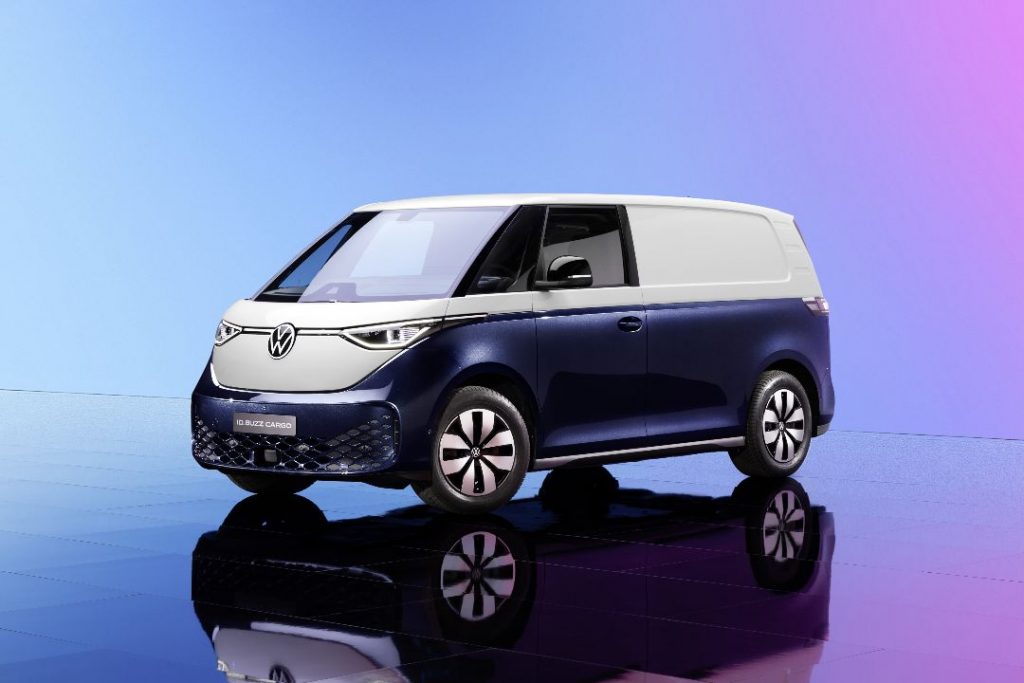
The Volkswagen ID Buzz Cargo is a brand-new electric van that takes its inspiration from the classic Volkswagen Type 2 campervan.
It sits between the Volkswagen Caddy and the Volkswagen Transporter T6.1 in the Volkswagen range in terms of its size and is built on Volkswagen’s shared MEB electric drivetrain platform. Despite being a van, with a load volume of up to 3.9m3 and 650kg, the ID Buzz Cargo actually borrows many of its features from Volkswagen’s passenger car models including the Volkswagen ID.3 and the Volkswagen ID.4 passenger cars.
A 150kW motor powers the van, producing 310Nm of torque in the process. There is currently just one battery option, a 82kWh unit providing a claimed range of up to 256 miles. Charging from 5% to 80% can be done in less than 30 minutes thanks to a maximum charge rate of up to 170kW on a DC charger.
For those needing more payload, a smaller battery pack size is likely to be added to the line-up reducing range but pushing capacity to around 750kg.
Two trim levels are available, Commerce and Commerce Plus, with entry-level models receiving a high level of equipment including LED headlight, a heated driver’s seat, front and rear parking sensors, 10” touchscreen and wireless App-Connect for Apple CarPlay and Android Auto. Commerce Plus models get Adaptive Cruise Control, keyless entry, Park Assist Plus with memory function which allows you to effectively record difficult parking manoeuvres to be automatically repeated. There are also safety features including driver assistance systems like Travel Assist, Lane Assist, Side Assist and Emergency Assist.
Prices start from £38,125 and includes three services and an MoT.
VERDICT: The Volkswagen ID Buzz Cargo’s biggest problem is its price but if you can get over that it is a brilliantly trendy, practical and accomplished van. It’s really a passenger car at heart, but unlike so many where the seats are removed and some blacked out windows added, the ID Buzz Cargo has been co-developed as one so it gets the best of both worlds. Loads of smart tech, super-fast charging, and reasonably good at both volume and payload. It's very nearly the best small electric van of 2022.
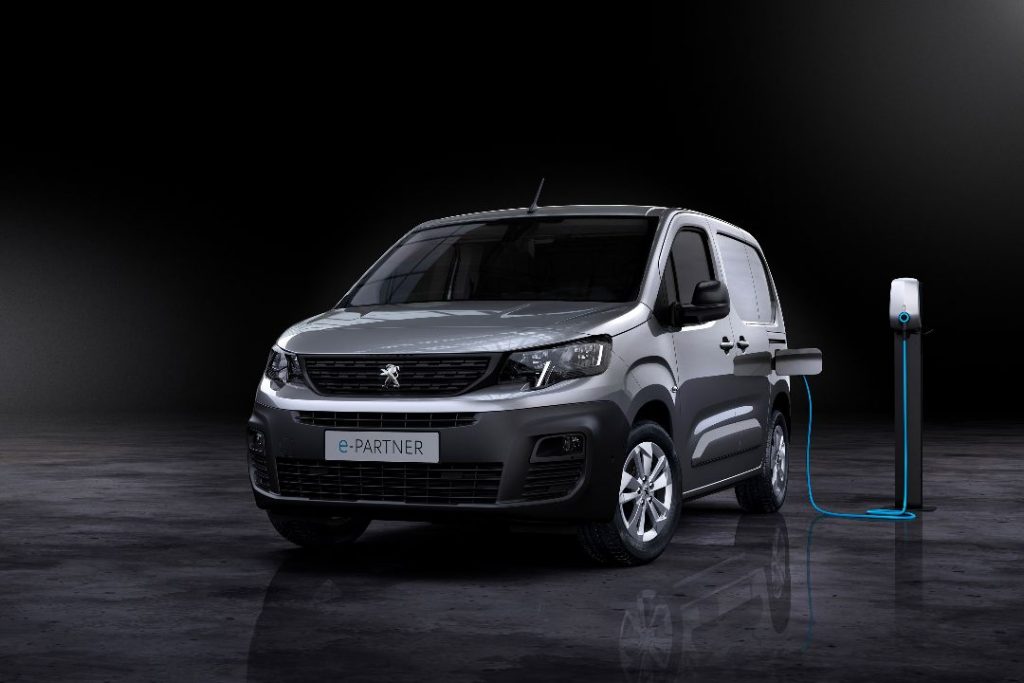
The city vans of Citroen, Peugeot, Toyota and Vauxhall have taken the successful underpinnings of the medium-sized electric van from Stellantis and applied it to the compact packaging of their small van range.
Built in France for Stellantis siblings Citroen, Peugeot and Vauxhall and also produced on behalf of Toyota, the van leads the small van sector with a 171 mile range from a 50kWh battery pack and is paired to a 100kW (136bhp) motor producing 260Nm of torque. Despite being small, the vans offer a load capacity of 4.4m3 thanks to a load-through bulkhead with folding passenger seat which extends the 3.3m3 and 3.9m3 capacities of the standard and long wheelbase vans.
The four vans can also have a very respectable payload of up to 800kg and have a towing capacity of 750kg. For added versatility, they can be specified with a E-Power take off system to power conversions such as fridge units. Charging can be carried out using 100kW charger, taking the battery from zero to 80% in 30 minutes.
The van’s comfortable cabin is focused around the driver with an angled 8in infotainment and navigation touchscreen, and includes several premium features like wireless phone charging and a Surround Rear View system giving a 360-degree view around the van. In total there are 18 driver assistance systems designed to make the van safer for both drivers and other road users.
Prices start from around £27,000 depending on the brand.
VERDICT: These small vans have been on sale for more than a year, coming to market in the autumn of 2021 but they still manage to deliver what the electric audience needs. They’ve not been left behind by the changes in technology either, with powerful motors, decent battery range and the option of both standard and high specification models.
If you want a decent all-rounder these three make a good bet, and the Toyota even comes with a longer warranty.
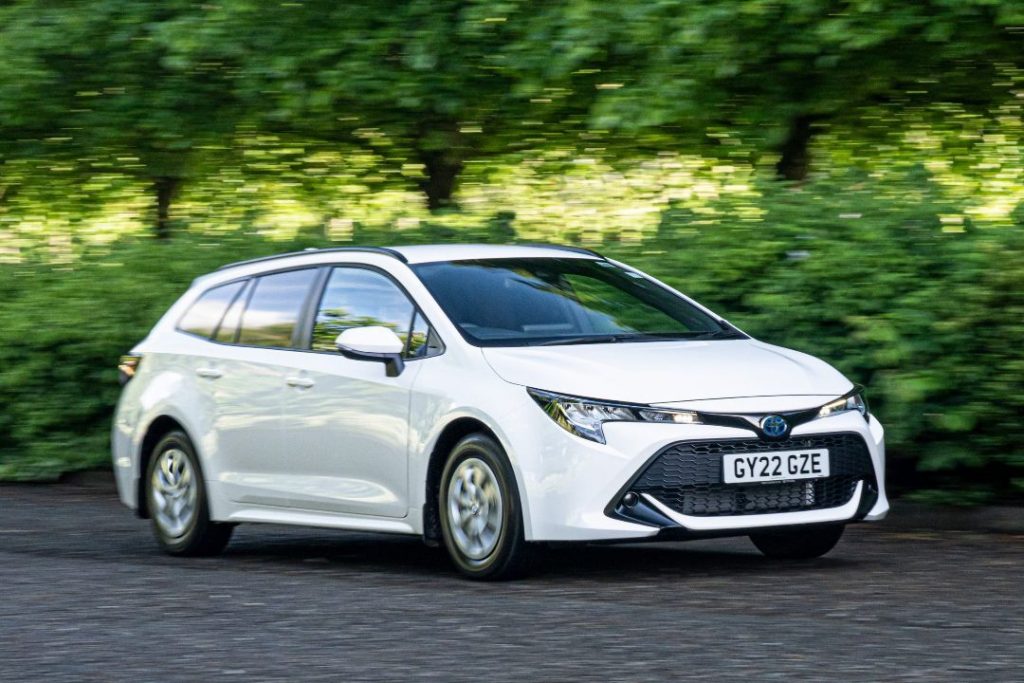
It’s been years since the Astravan disappeared from sale but the Toyota Corolla Commercial Hybrid van more than makes up for the shortfall.
Based on the Corolla Touring Sports estate passenger car, it is a full self-charging hybrid electric van. It looks, feels and drives like a car, but has a healthy 1.3m3 loadspace area in place of the rear seats.
Power comes from a 1.8-litre petrol engine and is paired to a 53kW electric motor, together the petrol hybrid Corolla Commercial produces up to 90kW (120bhp) and 142Nm of torque.
It’s the only engine choice and there’s also only one trim level but the interior is far from your typically commercial vehicle.
The Corolla Commercial gets a decent level of equipment including heated seats, dual-zone climate control and a reversing camera. There’s also LED headlights as standard. When it comes to safety, the Corolla Commercial Hybrid isn’t short on features. It gets adaptive cruise control, high beam assist headlights and lane keep assist as standard. Lane Trace Assist also helps to keep the van in the centre of the lane even while turning slight bends, and there’s Road Sign Assist to remind you of the speed limits with an audible or visual warning.
In the rear, the loadspace floor gets a rubber lining and there is a full-height steel bulkhead to protect the front seat occupants. There’s also an interior light and a 12v power outlet but the important figure is the 425kg payload and 750kg towing capacity.
Prices start from £22,149, excluding VAT.
VERDICT: A self-charging hybrid has managed to sneak into our best small electric vans of 2022 review but with good reason. That’s because the Toyota Corolla Commercial Hybrid is one hell of a package.
It’s a car to van conversion like any other with some questionable sticky window coverings but average fuel consumptions knocking on the door of 60mpg in the real world can’t be sniffed at.
It doesn’t suit everyone, but it brings back a niche segment and adds an electric spin to it. We’re grateful for the effort.
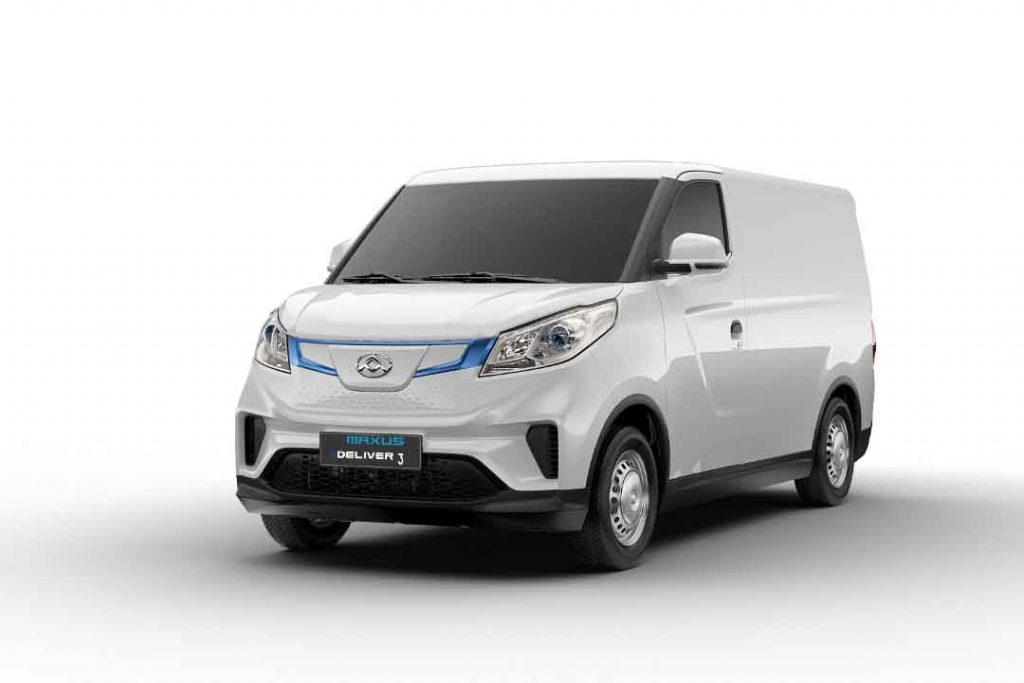
Arguably the first electric van to be launched that was conceived purely as an EV, the Maxus e Deliver 3 was nevertheless a big departure for Chinese-owned Maxus whose line-up had previously consisted of both diesel and electric models.
Designed from the ground-up as a pure electric van with a heavy focus on its aerodynamic performance, the e Deliver 3 has a claimed range of up to 213 miles for its WLTP city range and 151 miles for the combined WLTP standard. It has the option of two battery packs with either 35kWh or 50kWh cells and is paired to a 90KW motor producing 255Nm of torque.
It can carry up to 945kg of payload and despite only being available in a short wheelbase has a volume of 4.8m3. It is the smaller sibling to the large electric van Maxus E Deliver 9 and Maxus E Deliver 7.
Charging times using a DC rapid charger will see the battery level go from 5% to 80% in just 45 minutes, while a three-phase 11kW AC charge will take around five hours.
Standard features include air conditioning, built-in Sat Nav, smartphone mirroring with Apple CarPlay and Android Auto compatibility as well as USB and Bluetooth connectivity.
Operators can also have the e Deliver 3 as a chassis cab and can get real-time telematic data through a partnership with Geotab.
Its most appealing feature, however, is its price with models starting from just £27,000 with a government grant.
VERDICT: We’d love to put the e Deliver 3 much higher in our list of the best small electric vans you can buy in 2022 but it’s not quite the complete package. The battery range is impressive, and there’s adequate power from the motor, but its all the bits and piece in the cabin that let it down. An infotainment system that is frustrating (when it works) and a other little software gremlins too.
Launched in 2020 it fills a natural hole left by the Nissan eNV200 which is definitely a good thing, but it can’t match the finesse of the newer models.
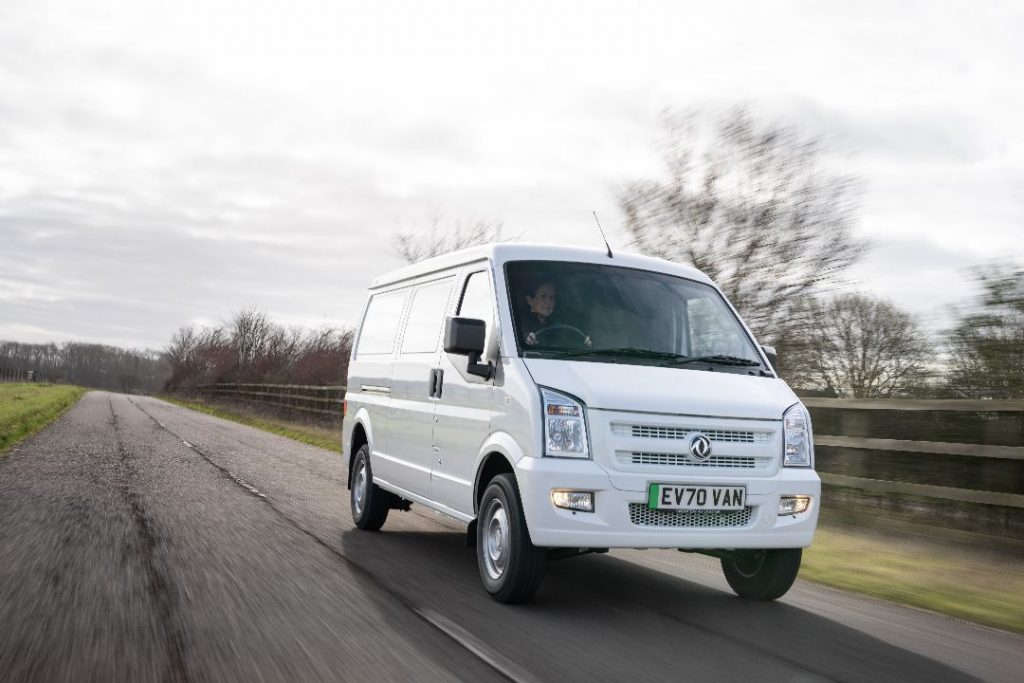
Chinese-made DFSK vans have made a comeback in the UK through importer Innovation Automotive with the quirky midi-van offering a cheap entry-level price to electric van ownership.
The DFSK EC35 looks like a typical Japanese-style microvan with high sides and a narrow width of just 1680mm. It’s unusual proportion don’t mean it is lacking in space with a maximum loadspace volume of 4.8m3 and an equally impressive payload capacity of 1,015kg thanks to its lightweight 1585kg kerbweight. It has a hinged rear tailgate and gets twin sliding doors as standard.
Power comes from a 60kW (80bhp) motor paired to a 39kWh lithium-ion battery with 200Nm of torque. While options are few and far between, one thing you can choose is the maximum speed limit of the van, with a 50mph limited model or a faster 62mph van. Depending on which version you choose will dictate how far you might be able to travel with a claimed range of 101 miles or 166 miles, according to the WLTP testing cycle, for the slow and fast versions respectively. The DFSK EC35 is able to be charged at a maximum rate of 40kW with the battery level going from zero to 80% in around 60 minutes. Topping up the battery to 100% on a 40kW charger will take 90 minutes, while charging from a 7kW wall box will take 6 hours.
Prices start from £20,999 excluding VAT.
VERDICT: Being entirely honest with you, the DFSK is only on the list out of courtesy. It’s not a particularly good van.
But, it will certainly do the job for the right sort of person. If you need to move things around at a walking pace, don’t want to go all that far or need to charge up that often it might just be the van for you.
If you spend more time out of the van than in it, then give it a chance. The price tag is too good not to consider it.
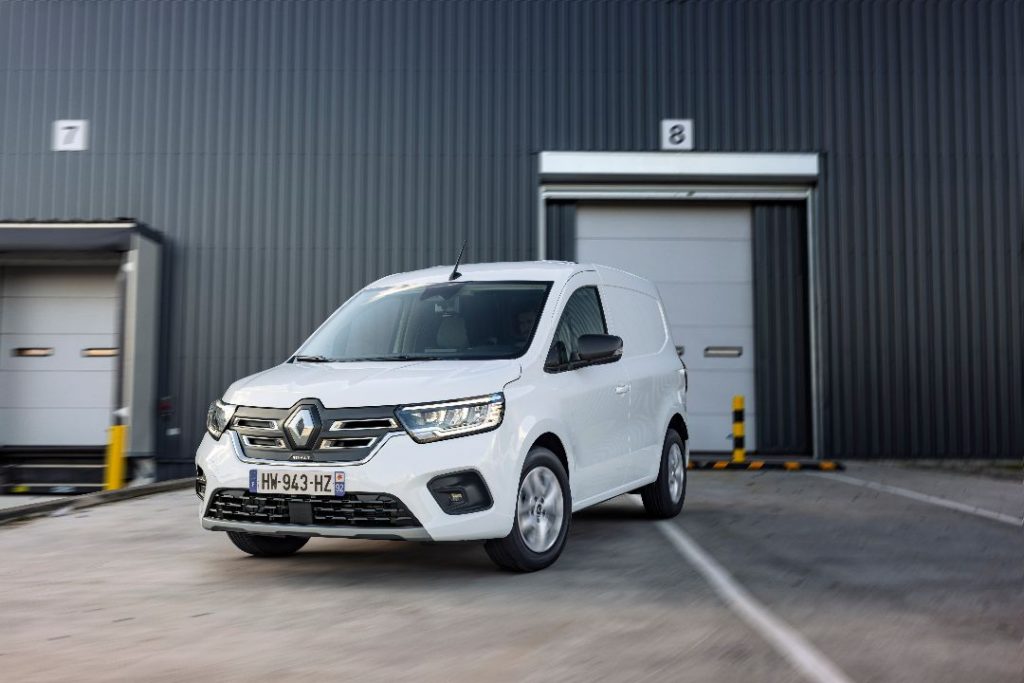
The Renault Kangoo is the oldest and most established name in the small electric van field but the latest version shares only its name with the trailblazer model launched in 2012.
The latest van returns with a new E-Tech name to reflect the rest of the electrified Renault models and is accompanied by two cousins with versions from Mercedes-Benz and Nissan. The three models offer a different take on the electric city van, with Mercedes opting for a more upmarket interior and more standard safety systems than the Renault, while Nissan plays off its warranty support and value.
All three vans, however, use the same 90kW motor paired to a 45kWh battery pack. Range for the vans is 186 miles, while charging can be carried out using an 80kW supply to add more than 100 miles in less than 30 minutes. Slower 22kW charging is also possible as well as a from domestic single-phase 7kW supply though a wallbox which is said to take six hours.
The van is available in two wheelbase lengths with the standard van having a 3.9m3 load volume and the long-wheelbase model up to 4.9m3 of capacity. Payload for regular vans will be up to 600kg but thanks to a higher gross vehicle weight the larger models can transport up to 800kg. They also have a 1,500kg towing capacity.
Prices start at around £30,000 for the Nissan version.
VERDICT: The diesel Renault Kangoo and Mercedes-Benz Citan are both excellent vans, and while the Nissan Townstar Electric is only available as a petrol model, the real strength of these models is the electric version.
Quiet, comfortable and way bigger than the previous generation vans, the Kangoo E-Tech, eCitan and Townstar electric really are the best small electric vans of 2022.
In summary, there's a large amount of choice in the small van market at the moment, and there's bound to be more with a Ford E-Transit Connect likely to be added to Ford's electric van range.